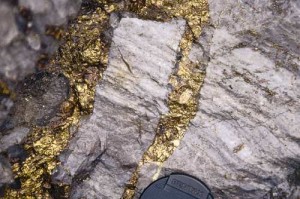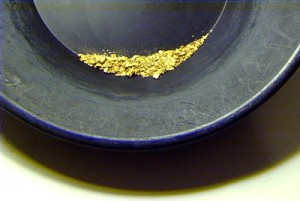Where to Find Gold Deposits: The Different Types of Gold Deposits


A vein of gold deposited into rock
Just starting out with the hobby of amateur gold prospecting and want to know where to find gold deposits? Before you get out into the field to try your hand at gold panning or metal detecting, it’s worth taking a moment to learn about the different types of gold deposits. Some kinds of gold deposits (like placer deposits) can be collected by amateur prospectors with pans or metal detectors, while others can only be mined my large corporate mining operations with expensive equipment and manpower.
Lode Gold Deposits (Veins of Gold in Rock & Gold Ore)
Veins of gold in rocks and gold ore under the ground (and sometimes above the ground) are called lode deposits. Although the exact method of how lode gold is formed is the subject of dispute among some geologists, many scientists belie that lode gold is deposited underground due to the circulation of water.
In this hypothesis of lode gold creation, water seeps into the earth and is subjected to super heat and pressure from magma. When this ground water is under extreme pressure, it has a tendency to absorb other minerals from rocks surround it it. Later, when that same water returns closer to the surface of the earth, it cools down and results in the precipitation of gold (and other minerals) out of the liquid. This process is thought to be one way that veins of lode gold are created.
It’s worth noting that a lot of gold vein lode deposited were created along with quartz deposits.
Placer Gold Deposits (Gold Dust, Flakes & Nuggets in Streams and Creeks)
 Placer gold deposits start out as lode gold deposits in rock. After many, many years of being subjected to the elements of temperature, wind, water and time, gold-bearing rock can erode and break down. These broken-down pieces of ore are crumbled over time into smaller particles, then eventually carried away by streams, creeks or rivers.
Placer gold deposits start out as lode gold deposits in rock. After many, many years of being subjected to the elements of temperature, wind, water and time, gold-bearing rock can erode and break down. These broken-down pieces of ore are crumbled over time into smaller particles, then eventually carried away by streams, creeks or rivers.
Because gold is so much heavier than other materials, it gradually sinks to the bottom of the sediment in the stream until it comes to rest at bedrock beneath the sand or in cracks and crevices. These deposits of gold are called “placer deposits.”
The process of gold panning uses the fact that gold particles and flakes are heavier than the other material in the stream; experienced gold prospectors know the best places to look for heavy gold particles at bends in creeks, sandbars, near the shore of streams, and in cracks of rocks. They then use the panning process to shake the heavy gold flakes to the bottom of their prospecting pan and get rid of the lighter, worthless sediment and stones until all they are left with is gold.
Gold Deposits from Volcanic Activity
A third method that deposits gold in the earth involves the cooling of lava, or magma, from volcanoes. In fact, most of the mined minerals on our planet are taken from volcanic deposits that exist beneath volcanoes that are long-since extinct and extinguished.
This method of gold deposit accumulation is simple to understand: the magma and lava simply melts the surrounding rocks, and in its liquid form, minerals like gold circulate up into the cooler, higher areas. Once the circulated magma with gold cools off (if this process does not result in an eruption), it cools off, becomes solid, and later results in gold deposits.

